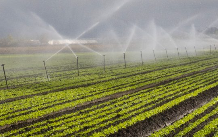Horticulture News
By: Scott Eckert, Harvey County Extension Agent, Horticulture
“Shallots are for babies; onions are for men; garlic is for heroes.” I heard this quote from an unknown author it has stuck with me. Garlic is a strong-flavored onion relative that is also grown by planting a division or clove in the fall. After overwintering, the bulbs are ready for harvest in June-July when the tops begin to turn yellow.
Garlic grows best in well$B!>(Bdrained, fertile, sandy loam soil. It prefers a slightly acidic pH of 6.3$B!>(B6.8. Looser soil aids in the development of larger bulbs, so tilling the soil before planting is recommended.
Amend the soil with compost and apply phosphorus if indicated by a soil test. Phosphorus is the key nutrient for good growth of garlic bulbs.
It is best to rotate the planting location from year to year and to not plant garlic in the same location where onions or other related plants have been grown recently.
Garlic should be planted in the first part of October and overwintered for harvest the following summer. It can be planted later in the fall, but yield may be reduced. Spring planted garlic will have significantly smaller bulbs and lower overall yield.
To plant, break the bulbs into individual cloves. Do not remove the papery skins from the cloves. Plant within 5 days to prevent the cloves from drying out.
One pound of garlic typically yields a 30$B!G(B planted row, although different varieties will yield a different number of cloves per pound. Larger cloves will typically produce larger bulbs.
Cloves should be planted 2$B!I(B deep with the blunt end down and the tip pointing up. Plant cloves 6$B!I(B apart in rows 12$B!I(B apart. In a raised bed, rows need only be 6$B!>(B8$B!I(B apart.
Water thoroughly after planting. Water as needed when the soil is dry. Mulching with straw or leaves is recommended but not required for successful growth. Put the mulch down in the late fall or early winter.
Most garlic varieties will be ready to harvest in late June to mid$B!>(BJuly. The best indicator of time to harvest is when 5 of the outermost leaves have yellowed and died. When 3 to 4 leaves have yellowed, discontinue watering.
Dig the whole plant with a garden fork and let dry in a shady spot with good air circulation for one day. Then brush the excess dirt from the bulbs and tie the plants in bunches. Hang the bunches, bulb down, in a shady, well$B!>(B ventilated location. They will require 2 to 3 weeks to dry sufficiently. Properly dried garlic will last longer.
When drying is complete, clip the roots short and trim the leaves, leaving about 1$B!I(B of the neck. Store the dried bulbs in mesh bags in a cool, dry area. Ideal storage conditions are 50 degrees F with humidity less than 60%. For longer storage, place the bulbs in paper bags in the vegetable drawer of the refrigerator. The garlic will remain usable until February or March.




